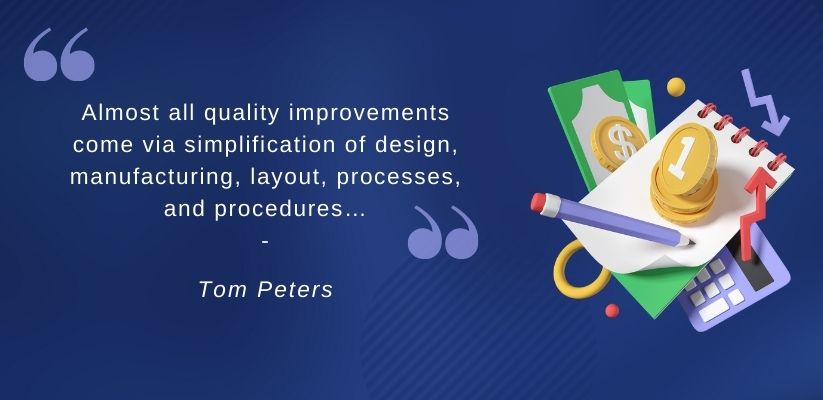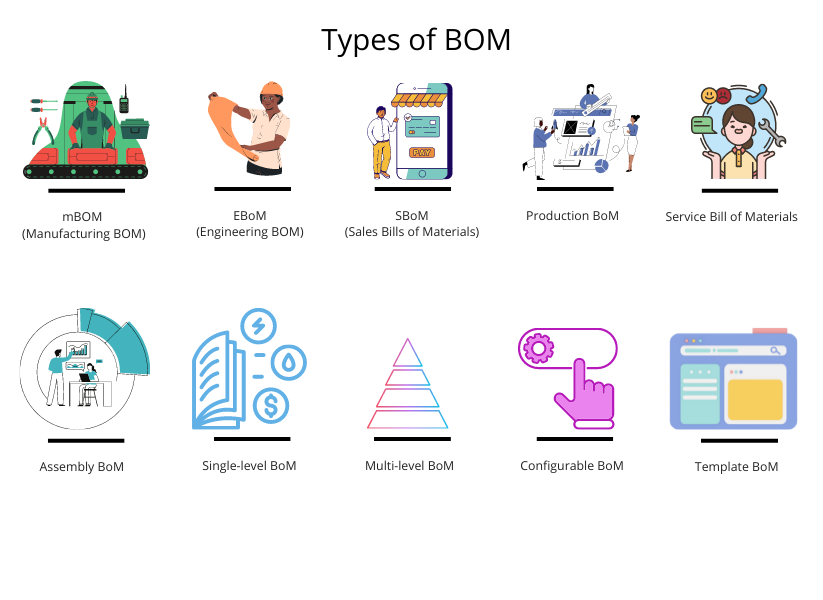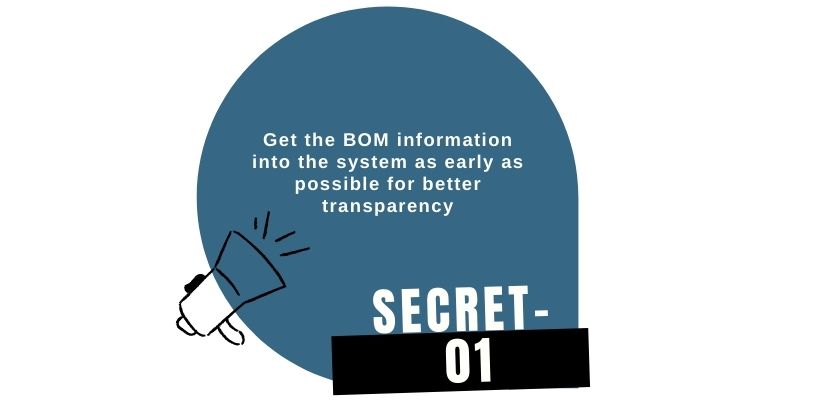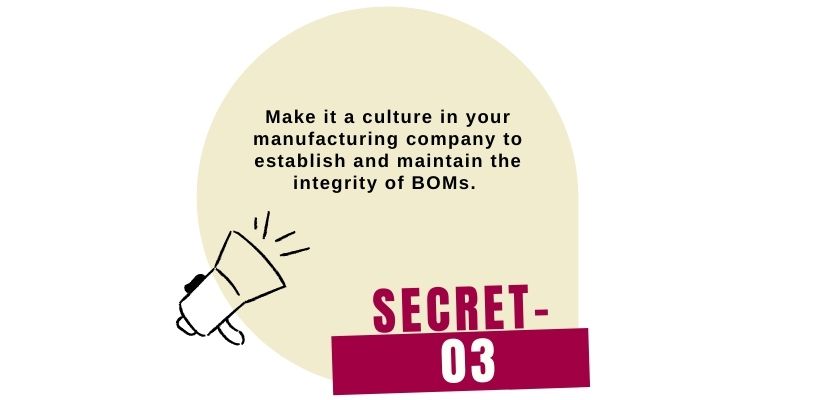SUMMARY: Manufacturers make use of BOM (Bill of Materials) to build products. Generating an accurate bill of materials is pivotal since it makes sure that the required parts are available. It also ensures that the assembly process is quite efficient to proceed. In this blog post, we will see 10 types of BOM and their significance.

Bill of Material is popularly known as BOM. It is the prime function of a company in manufacturing inventories.
BOM helps companies in designing, checking cost estimation, planning inventories, and more.
Let us explore more about the types of BOM, its, and its significance in various industries.
What is the Bill of Material BoM?
A Bill of material is a detailed list of assemblies, components, and raw materials needed to make a product. BOMs also comprise necessary guidelines to gather and utilize the ordered materials. It is the first step you would take to make the final product and has excellent usage in manufacturing industries.
BOMs include detailed information and a lot more data about raw materials and the status of the product.
<< Also Read: How can Manufacturing ERP help businesses function smoothly?>>
Types of BOM
Though there are different types of BOM, we will look into the 10 most used bill of material in the manufacturing and engineering industry.
1. mBOM (Manufacturing Bill of Materials)
It is one of the major types of BOM. The manufacturing bill of materials is the most widely recognized BOM for assembling companies.
It is specifically used when a manufacturing unit needs to show all assemblies and their components required to make the finished product. The bill of materials mBOM depends totally on the accurate number of parts ordered in the manufacturing process. Material BOM is a bill of material created for a material. They are mainly used to showcase the structure of products manufactured in the company. It is a type of BOM which is widely used in manufacturing companies.
2. EBoM (Engineering Bill of Materials)
The engineering bill of materials mentions the assemblies and parts developed and designed by the engineering department. The engineering bill of materials includes mechanical and technical drawings of the particular product, which showcases the functionality of the product.
Bill of materials EBoM is all about the designing view of a product rather than a manufacturing view. Engineers make use of different tools such as Computer-aided design.
(CAD)/ Electronic design automation (EDA) to develop an Engineering bill of material. Bill of materials EBoM helps companies purchase decisions on the needed requirements and can offer integrated manufacturing data. It also helps clear unnecessary data revisions.
3. SBoM (Sales Bill of Materials)
A sales bill of materials offers data about a particular product already in the sales stage. It also includes product details before assembly. Each BOM has a distinguished structure that displays different standards of fact. Likely, SBoM signifies the management of a finished product as in sales item.
<< Also Read: How to better manage Inventory in the Food Production Industry?>>
4. Service Bill of Materials
A service bill of material is among the top types of BOM. It is specifically designed for service technicians who need a list of various parts, repairing guidelines of products, installation steps, and more. The service bill of materials might be used at the customer’s venue or any other installation place of the product.
5. Production BoM
Production BoM includes all components, bills of assemblies, measuring units, and sub-assemblies. Production bill of materials BOM is the most critical factor in the production order. All individual parts are put together to make wholly assembled products in the production stage.
With a fully-advanced BOM system, all expenses and availability of components can be edited in the work orders. This function makes sure that the raw materials are correctly allotted to the products.
6. Assembly BoM
The Assembly bill of material is quite the same as that of Sales BOM and lists the parent item as a sales item despite inventory products. The Assembly bill of materials includes the finished products only in the sales document and could be multi or single-level.
<<Also Read: The Impact of Poor Inventory Management in Discrete Manufacturing>>
7. Single-level BoM
Single-level bills of materials are usually used when products have a simple structure and do not include any subassemblies. Such a document leverages single-level children in assemblies, raw materials, and components.
A single level BOM contains an all-out check of the parts utilized in the product development. Then, these parts are recorded in the part numbers order for better accuracy.
8. Multi-level BoM
A multi-level bill of material is another one of the best types of BOM which is utilized for closely related small departments. Hence it embraces subassemblies broken up into some different subassemblies. In multi-level BOM, every part number is required to connect with a parent item right beside the top-general column. Here, the part number can either be a crude material or work.
9. Configurable BoM
The configurable BoM is genuinely needed in industry sectors dealing with highly configured products. These products include heavy machinery or industrial machinery. Hence, this BoM has components required for designing and manufacturing a product according to the client’s requirements.
10. Template BoM
The template bill of material is one of the flexible types of BOM. It is too flexible and can be used for both Sales BoM and Production BoMs. It shows the parent items at the top, followed through the below components. It helps you update, delete, or replace the no. of features in the sales order.
Why are BoMs Important?
Raw material acquisition and the complete process of assembling the parts depend on types of BoM, affecting inventory. An inappropriate BoM can call a lot of revisions and the income loss of individuals in the procedure. Suppose the cost and count of parts are mistakenly entered, then it could lower the group’s productivity.
Now, let us see some important aspects of various types of BoM.
Product-related types of BoM-
You can refer bill of materials as a shopping list since it has many details about the raw material. The details include number, name, quantity, and more. This helps build a simple procurement of raw materials.
Improved costing in various types of BOM-
Enhanced planning needs accurate data. Different elements, including no. of materials, guidelines, and time are required to aid the sales team work efficaciously. This help reduces better costing while improving the cost and work efficiency.
Enhanced planning-
The chalking out of projects regarding deadlines and the number of employees needed to complete the project are all included in project planning. The more detailed the list is, the more are the chances to oversee the project.
<<Also Read: Top inventory management techniques SMEs must follow>>
How can you create a Bill of Materials?
If you are thinking of creating different types of BOM Bill of Materials, consider the below points without any fail-
- BoM Level- It is the total no. or ranking of assembly and part, which is offered in extensive BoM. The level should be portrayed such that it should be simple for all components of the bills of materials.
- BoM notes- These notes include some extra crucial data besides the BoM components.
- Part name- A particular name given to every part allows you to check that part effectively instead of preventing it from other sources.
- Part number- Part number is unique to every aspect and gives an easy reference of parts engaged in the cycle of manufacturing. This specific part number also assists in checking the details.
- Quantity- It highlights the number and amount of factors needed in every assembly to create BoM. This tool helps with precise purchasing.
- Procurement type is the method by which every part will be acquired.
- Unit of Measure- It is an integral part of BoM and is specially used to check the material or component. A few of its examples are inches, ounces, and feet. This tool makes sure the quantity bought is exact and has been conveyed to assembly lines properly.
- Phase- Multiple phases check the various stages in the product life cycle. Sometimes, these stages are the ‘production phase’, ‘in-production phase’, and ‘unreleased phase’.
- Description- Every part or material inside BoM should have an extensive description. Its prime aim is to make it easy to read the document and understand the material in detail.
- Reference designators- They are used whenever a product has printed circuit board assemblies. They are used to check how the part fits on the circuit boards.
Wrapping up
Here we have discussed the most used types of BOM in manufacturing companies. BOMs help makes successful commercialization a reality. Before creating a BOM record, always think about who would authorize the data. Also, you should manage all corresponding parts as well as documentation.
Different types of BOM are complicated and reflect the complexity of the product development process along with the complexity of the product. It is quintessential to set a perfect language and the definition in the organization. This helps simplify the communication and streamline the business operations.
STAY UPDATED
Subscribe To Our Newsletter
At Sage Software Solutions (P) Ltd., we are home to world-class ERP software and CRM software that will solidify your business tech support fundamentals and enable you to build a customer-centric organization. You can also write to us at sales@sagesoftware.co.in.
Disclaimer: All the information, views, and opinions expressed in this blog are those of the authors and their respective web sources and in no way reflect the principles, views, or objectives of Sage Software Solutions (P) Ltd.









